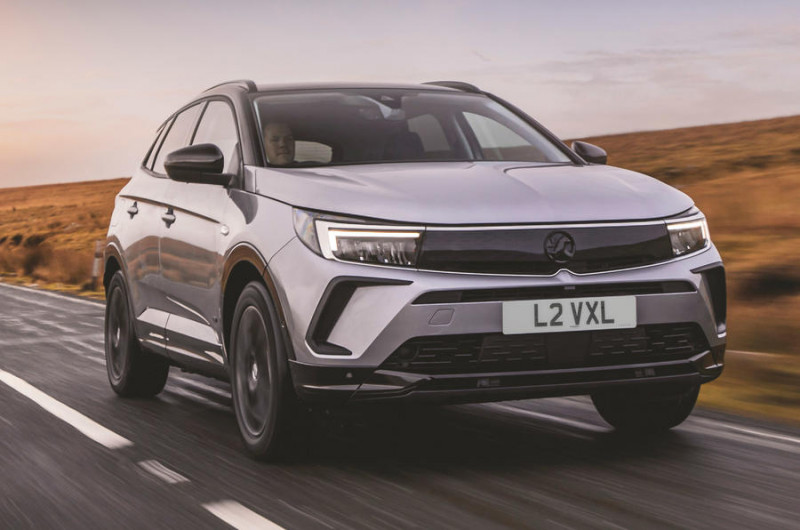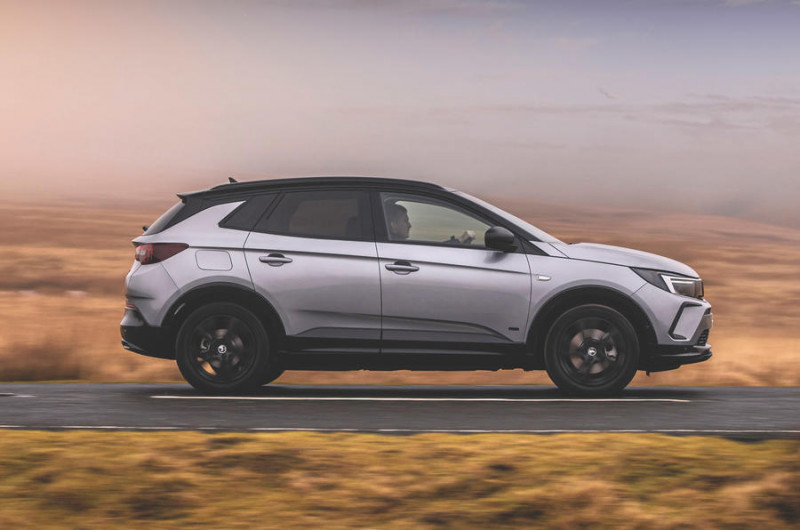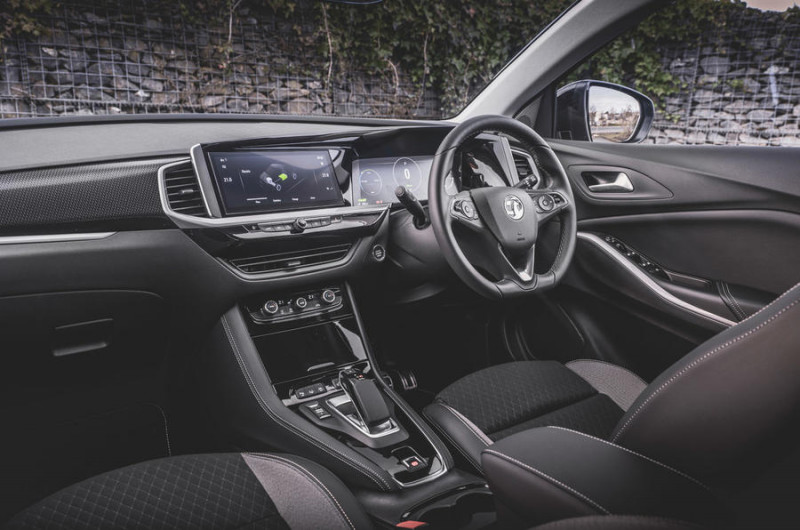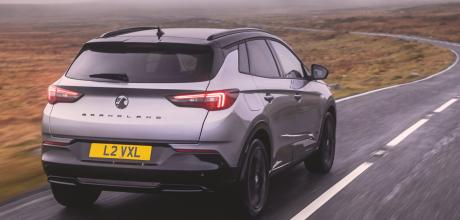2023 Vauxhall Grandland GS Line 1.6 Turbo PHEV
Vauxhall is on a mission to totally reinvent its lineup. The new ’Vizor’ design language was revealed on the GT X Experimental concept car, and the fresh look rolled out to the Mokka, the new Astra, and the latest incarnations of the Crossland and Grandland.
FIRST UK TEST
Only the Corsa, Insignia and the company’s van based MPVs are still to adopt the more radical appearance. Here we test the Grandland, which has been enlivened no end by the adoption of the new styling, where previously it could be accused of being a little on the bland side. Extensive colour coding, wing-style headlights, twin displays for the interior and an uplift in technology are the major changes, even if the powerplants remain largely the same. Finally, the line-up has been streamlined with just three trim levels – Design, GS Line and Ultimate – a theme that is common to the entire car line-up.


We take delivery of a long-term Grandland diesel in just a few weeks, so we concentrated on the plug-in hybrid edition of the car at the UK launch in the pretty Cotswolds. With CO2 emissions of 31g/km and a pure electric driving range of 39 mile, this is the vehicle to choose if you’re a company car driver, on account of its low benefit-in-kind taxation. This plugin hybrid is rated at 12% compared to a hefty 31% for the equivalent diesel. No wonder so many business users are abandoning their diesels in favour of electrified vehicles. There’s gutsy performance away from the lights from the 1.6-litre turbocharged petrol engine, with plenty of overtaking potential on faster roads. The drivetrain switches from electric to petrol in an imperceptible manner, with the Grandland starting off in the zero emissions mode initially and chipping in with the combustion engine as and when required, or if there’s no available range. Slot the joystick-controller into ‘D’ to start off, or if you want to increase the level of brake regeneration, slide it one more notch into ‘B’. While the Grandland can’t operate using a single pedal arrangement like the Nissan Leaf and other vehicles can, there’s additional harnessing of the energy that brings you to a stop more quickly.

You’ll be unsurprised to learn that the Grandland feels very much like a Peugeot 3008 in the way that it drives, as the two cars share underpinnings. There’s taut, tidy handling through the bends and steering that is relatively light and responsive. It feels particularly manoeuvrable around town, where it makes parking very easy. Refinement is good, with a well hushed engine that only gets raspy if you’re making hay with the right-hand pedal. Pleasingly, road, tyre and wind noise levels are nicely contained. Ride comfort is good, with the worst lumps and bumps soaked up well.
The cabin of the previous Grandland X was always a bit of a let-down, but this has been transformed with the latest car, thanks to twin black panel screens – 12- and 10-inches, respectively. They deliver a more hi-tech appearance, and the infotainment touchscreen is usefully angled towards the driver. There’s a full complement of features, including Android Auto, Apple CarPlay and Bluetooth, as well as a navigation system. Pleasingly there’s a knob to control the volume, rather than plus and minus buttons, and separate ventilations controls, instead of being integrated into the touchscreen, like its Peugeot cousin. Material quality is enhanced, with a squidgy dashboard top and semi-soft door tops.
The faux leather and cloth sports seats are nicely bolstered, but there’s a feeling of being perched on top of the chairs, rather than being ensconced within them. It’s pleasing that there’s front and rear parking sensors and a 180-degree rear camera as the view through the window isn’t exactly brilliant. Large, deep door mirrors make manoeuvring in tight car parks easy.
Headroom is pretty good front and back, with the amount of knee and leg space well up to class standards. Cargo carrying capacity is compromised on this plug-in hybrid edition compared to the diesel, with just 390 litres of space, compared to 512 litres on the diesel. Fold the rear chairs down using the boot mounted levers and there’s 1,528 litres, compared to 1,652 litres by opting for the diesel. Peer underneath the boot floor and there’s a series of handy trays that boosts versatility.
FACTS & FIGURES 2023 Vauxhall Grandland GS Line 1.6 Turbo PHEV
- On sale Now
- In showrooms Now
- Prices £28,310 to £37,375
- Bodystyles 5-door SUV
- Engines 1.5 Diesel automatic (129bhp) 1.6 Petrol plug-in hybrid automatic (221bhp)
- Trim levels Design, GS Line, Ultimate
- Also consider Kia Sportage, Peugeot 3008
- Model tested GS Line 1.6 Turbo PHEV
- Price £33,820
- Built in Eisenach, Germany
- Codename Not known
- Generation 1 Facelift
- Platform EMP2
- Bodystyle 5-door SUV, 5-seats
- Layout Front-wheel-drive
- Powerplant 1,598cc, 4-cylinder, 16-valve, turbocharged petrol with electric motor and 13.2kWh lithium-ion battery pack
- Gearbox 8-speed automatic
- Max power (engine) 178bhp @ 6,000rpm
- Max power (electric motor) 109bhp @ 2,500rpm
- Max power (combined) 221bhp
- Max torque (engine) 221bhp @ 3,000rpm
- Max torque (electric motor) 236bhp
- Max torque (combined) 266bhp
- Top speed 140mph
- 0-62mph 8.9secs
- CO2 emissions 31g/km
- Economy (combined) 192.0mpg
- Tank 43 litres
- Range (electric motor) 39 miles
- Recharge time (Domestic socket/3.6kW home charger) 5 hours 45 minutes/3 hours 30 minutes
- Insurance 23
- BIK rate (2022/2023 tax year) 12%
- Size (length/width with mirrors) 4,477/2,098mm
- Boot space (min/max) 390/1,528 litres
- Kerb/max towing weight 1,735/1,250kg
- Euro NCAP rating (pre-facelift)
- Spare wheel (Full-size/spacesaver/run-flat/self-seal/repair kit) No/no/no/no/yes
- Warranty (Car) 3 years/60,000 miles
- Warranty (Battery) 8 years/100,000 miles
- Verdict This update has transformed the Grandland, with more distinctive looks, an interior that looks hi-tech and generous equipment levels.
- Rating ■■■■■■■■■■8/10


